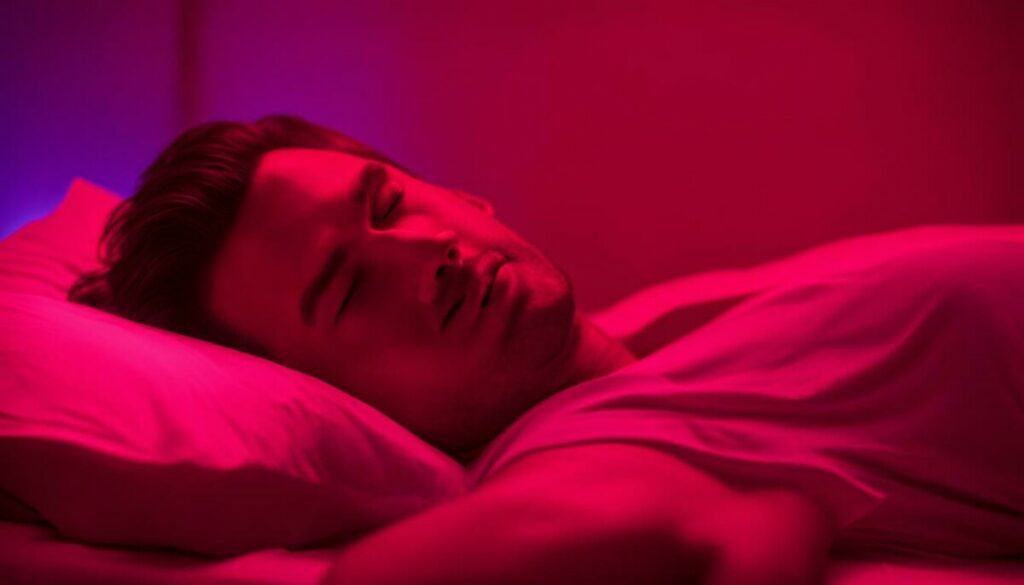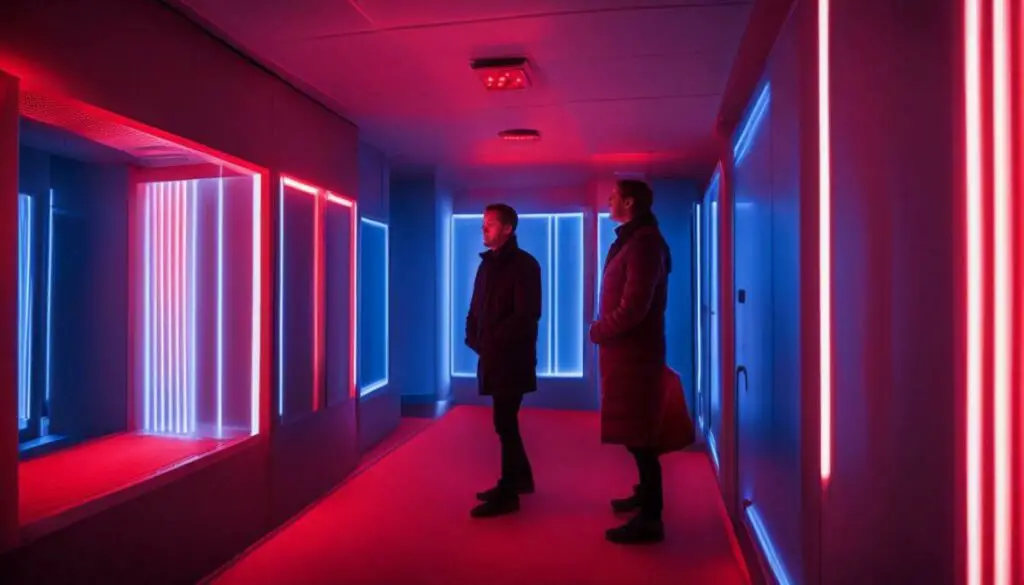Last Updated on 6 months by Francis
Are you considering trying out a wellness therapy to enhance your overall well-being? Cryotherapy and red light therapy are two popular options that offer unique benefits. While both treatments are non-invasive and relatively quick, they utilize different methods to help you achieve your wellness goals. Let’s explore the benefits, drawbacks, and treatment methods of cryotherapy and red light therapy to help you decide which therapy is right for you.
Contents
Key Takeaways:
- Cryotherapy and red light therapy both offer unique benefits
- Cryotherapy involves exposing the body to extremely cold temperatures while red light therapy utilizes low-level red light wavelengths
- Cryotherapy is thought to help reduce inflammation, boost collagen production, and increase metabolism while red light therapy is believed to improve skin health, reduce inflammation, and alleviate pain
- Both therapies have potential drawbacks, such as discomfort during the treatment or potential risks if proper precautions are not taken
- The decision between cryotherapy and red light therapy ultimately depends on your personal goals and preferences
Understanding Cryotherapy
Cryotherapy is a wellness therapy that involves exposing the body to extremely cold temperatures for a short period. This treatment is believed to offer various benefits such as pain relief, muscle recovery, and improved circulation.
It is typically done in specialized chambers or with localized applications. During a whole-body cryotherapy session, you stand in a cryo chamber filled with dry, cold air for 1-3 minutes. Alternatively, localized cryotherapy can be used to target specific areas of the body with cold air or ice packs.

Cryotherapy is also known to have a positive effect on the immune system by increasing the production of white blood cells. The cold temperature can also help reduce inflammation and swelling, promoting faster healing of injuries and wounds.
If you’re interested in trying cryotherapy, it’s important to find a reputable and experienced practitioner. They can guide you through the process and ensure that the treatment is safe and effective for you.
Exploring the Benefits of Cryotherapy
Cryotherapy has gained popularity in recent years as a wellness therapy that offers numerous benefits. This treatment involves exposing the body to extremely cold temperatures, typically for a short period. If you’re considering cryotherapy, here are some potential benefits to consider:
- Pain relief: Cryotherapy is believed to help reduce pain by numbing the affected area and reducing inflammation. This may be especially beneficial for those with chronic pain conditions like arthritis or fibromyalgia.
- Muscle recovery: Cryotherapy has been shown to help reduce muscle soreness and promote faster recovery after exercise. This may be helpful for athletes or anyone looking to improve their exercise routine.
- Improved circulation: Exposure to cold temperatures during cryotherapy may help improve blood flow and circulation throughout the body. This may have benefits for overall health and well-being.
- Boosted collagen production: Cryotherapy may enhance skin health by stimulating collagen production and improving skin elasticity. This can help reduce the appearance of wrinkles and fine lines.
- Weight loss: Some studies suggest that cryotherapy may help boost metabolism and aid in weight loss by increasing the body’s calorie-burning ability.
- Improved mood: Many people report feeling a sense of euphoria or “runner’s high” after cryotherapy. This may be due to the release of endorphins and other feel-good chemicals in the brain.
| Method of Cryotherapy | Description |
|---|---|
| Whole-body | This method involves entering a specialized chamber that exposes the entire body to extreme cold temperatures for a short period. |
| Localized | Localized cryotherapy involves using a device to target specific areas of the body with extreme cold. This may be helpful for injuries or areas of chronic pain. |
If you’re interested in cryotherapy, it’s important to talk to a healthcare professional to determine if it’s a safe and appropriate treatment for you. With proper precautions and guidance, cryotherapy may offer numerous benefits for overall wellness.

Understanding Red Light Therapy
Red light therapy, also known as photobiomodulation, is a non-invasive treatment that uses low-level red light wavelengths to stimulate the body’s natural healing processes. This therapy can be administered through specialized devices or in professional clinics and is painless.

This treatment is believed to offer numerous benefits like improved skin health, increased collagen production, and reduced wrinkles and acne. Red light therapy has also been shown to help with wound healing, inflammation reduction, and pain relief. Additionally, it has a positive impact on mood and sleep.
“Red light therapy is an innovative and effective non-invasive technique to help improve skin health, reduce inflammation and pain, and enhance overall wellness.”
During the therapy session, individuals are exposed to low-level red light wavelengths for a short period. The therapy is relatively quick and does not require any downtime.
However, it is crucial to protect the eyes during the treatment as prolonged exposure to high-intensity red light may cause eye damage. Follow safety guidelines and use appropriate eye protection to minimize any potential risks.
Exploring the Benefits of Red Light Therapy
Red light therapy has gained popularity in recent years due to its numerous potential benefits. This therapy is non-invasive and painless, making it a convenient option for many individuals.
One of the primary benefits of red light therapy is improved skin health. The therapy has been shown to increase collagen production, reduce wrinkles and acne, and aid in wound healing. Red light therapy may also reduce inflammation and alleviate pain.
Besides physical benefits, red light therapy may also have positive effects on mood and sleep. Research has found that the therapy may help alleviate symptoms of depression and improve overall well-being.
If you’re interested in trying red light therapy, there are various treatment options available. The therapy can be administered through specialized devices or in professional clinics. It is important to follow safety guidelines, particularly when it comes to protecting your eyes during the treatment.

Exploring the Benefits of Red Light Therapy
To summarize, red light therapy offers numerous potential benefits, including improved skin health, pain relief, and mood enhancement. If you’re considering red light therapy, it’s important to discuss the treatment with a qualified healthcare professional to determine if it’s a suitable option for you.
Comparing the Treatment Methods
When it comes to cryotherapy treatment, the process involves exposing the body to cold temperatures, either in a whole-body chamber or with localized applications. In contrast, red light therapy treatment utilizes low-level red light wavelengths and can be administered using specialized devices or in professional clinics. Both treatments are non-invasive and relatively quick, making them popular options among wellness enthusiasts.
While cryotherapy and red light therapy may differ in their approach, they can both offer numerous benefits for the body and mind. Understanding the unique advantages and drawbacks of each therapy is essential to make an informed decision about which treatment is best suited for your needs.
| Cryotherapy Treatment | Red Light Therapy Treatment |
|---|---|
| Purpose: pain relief, muscle recovery, and improved circulation | Purpose: skin health, wound healing, and mood enhancement |
| Method: whole-body chamber or targeted applications | Method: specialized devices or professional clinics |
| Safety Precautions: risk of skin burns or frostbite if proper precautions are not taken | Safety Precautions: prolonged exposure to high-intensity red light may cause eye damage |

Choosing the treatment method that is best for you ultimately depends on your individual needs and goals. If you are looking for physical benefits such as pain relief and improved circulation, cryotherapy may be a suitable option. Conversely, if you are interested in the potential mental health benefits of red light therapy, such as mood enhancement, it may be a better fit.
Combining cryotherapy and red light therapy treatments is another option. This approach may offer additional benefits and is often used for overall wellness. However, it is essential to consult with a healthcare professional before combining the therapies to ensure safe and effective use.
Before deciding on any treatment, it is crucial to seek the guidance of a qualified healthcare professional. They can assess your individual needs, provide personalized recommendations, and ensure that the treatment is suitable for your specific health conditions or concerns.
Drawbacks of Cryotherapy
While cryotherapy has numerous benefits, it is essential to consider potential drawbacks. Some individuals may experience discomfort during the treatment, especially those who are sensitive to cold. Additionally, there is a small risk of skin burns or frostbite if proper precautions are not taken. Cryotherapy is also not recommended for individuals with certain health conditions, such as diabetes or hypertension. It is crucial to consult with a healthcare professional before beginning a cryotherapy treatment to ensure it is safe for you.

Drawbacks of Red Light Therapy
While red light therapy offers numerous benefits, it is essential to consider its potential drawbacks.
One potential risk is eye damage from prolonged exposure to high-intensity red light. It is crucial to protect the eyes during the treatment and follow safety guidelines to minimize any potential risks. Additionally, red light therapy may not be suitable for those with certain skin conditions or light sensitivity.

Although these risks are relatively low, it is still important to discuss them with a healthcare professional before beginning red light therapy. They can help you weigh the potential benefits and drawbacks and determine if this therapy is right for you.
Choosing the Right Therapy for You
The decision to choose between cryotherapy and red light therapy can be daunting, but it ultimately comes down to your individual needs and goals. Both therapies offer unique benefits, and it is crucial to consider which one aligns with your wellness objectives.
If you are looking for pain relief, muscle recovery, and improved circulation, cryotherapy may be the right choice for you. It is known to reduce inflammation, boost collagen production, and enhance athletic performance. Cryotherapy can also aid in weight loss, improve mood, and alleviate muscle soreness and joint pain.
On the other hand, if you are interested in improving your skin health, wound healing, and mood, red light therapy may be more suitable. The therapy is believed to reduce wrinkles and acne, increase collagen production, and promote wound healing. Additionally, red light therapy has been shown to have positive effects on mood and sleep, making it a popular choice for those seeking overall wellness.
It is also worth considering combining both therapies to potentially enhance the benefits of both treatments. This approach can be beneficial for overall wellness, but it is important to consult with a healthcare professional to ensure safe and effective use of these therapies together.

Ultimately, the decision between cryotherapy and red light therapy depends on your personal preferences and desired outcomes. It is crucial to seek guidance from a qualified healthcare professional before starting any treatment to ensure it is suitable for your individual needs and health conditions.
Considering Combined Therapies
If you are seeking to maximize the benefits of cryotherapy and red light therapy, combining both therapies may be an option worth considering.
While each therapy offers unique benefits, they can work together to enhance overall wellness. For instance, cryotherapy may help to alleviate muscle soreness and joint pain, while red light therapy can aid in collagen production and skin health.
Combined therapy sessions can be tailored to meet your specific needs and preferences. However, it is crucial to seek guidance from a qualified healthcare professional to ensure a safe and effective approach.
By exploring the benefits and potential drawbacks of cryotherapy and red light therapy, you can make an informed decision about which therapy or combination therapy is best for you.

Seeking Professional Guidance for Cryotherapy and Red Light Therapy Treatments
If you are considering cryotherapy or red light therapy treatments, it is important to seek guidance from a qualified healthcare professional. These therapies involve unique methods and may not be suitable for everyone.
A healthcare professional can assess your individual needs, provide recommendations, and ensure that the treatments are safe and effective for your specific health conditions or concerns.
It is also crucial to follow proper safety protocols and guidelines during the treatments. For cryotherapy, this includes wearing protective gear such as gloves, socks, and underwear, and limiting the session time to avoid skin burns or frostbite. For red light therapy, it is important to protect the eyes from prolonged exposure to high-intensity light.
Overall, seeking professional guidance can ensure that your cryotherapy or red light therapy experience is safe and effective.
Consultation with a Healthcare Professional
A healthcare professional can provide valuable insights into the benefits and potential risks of cryotherapy and red light therapy treatments. They can evaluate your medical history, current health status, and wellness goals to determine if these therapies are appropriate for you.
Additionally, consulting with a healthcare professional can help you understand the proper dosage and frequency of the treatments. This can help maximize the potential benefits while minimizing any potential risks or side effects.
| Cryotherapy Treatment: | A qualified healthcare professional can assess your individual needs and ensure that cryotherapy is a safe and effective option for you. They can also provide guidance on how to prepare for the treatment and what to expect during the session. |
|---|---|
| Red Light Therapy Treatment: | A healthcare professional can help you determine if red light therapy is a suitable option for your specific health concerns or skincare goals. They can also recommend the appropriate devices or clinics for the treatment and provide safety guidelines for protecting your eyes during the therapy. |

Overall, working with a healthcare professional can help ensure a safe and enjoyable experience with cryotherapy or red light therapy.
Making an Informed Decision
After comparing cryotherapy and red light therapy, it’s crucial to make an informed decision about which treatment aligns best with your wellness goals. Consider factors such as your desired outcomes, any potential risks, and your overall comfort level with each therapy.
If you are seeking pain relief, muscle recovery, and improved circulation, cryotherapy may be a suitable choice. On the other hand, if you are primarily interested in skin health, wound healing, and mood enhancement, red light therapy may be more beneficial.
It’s also important to note that some individuals choose to combine cryotherapy and red light therapy to potentially enhance the benefits of both treatments. However, it’s essential to consult with a healthcare professional to ensure safe and effective use of these therapies together.
Ultimately, the decision between cryotherapy and red light therapy depends on your personal goals and preferences. Seeking professional guidance and making an informed decision can help ensure that you choose the therapy that is right for you.
Cryotherapy vs. Red Light Therapy Comparison: A Summary
| Therapy | Benefits | Drawbacks | Treatment Methods |
|---|---|---|---|
| Cryotherapy |
|
|
|
| Red Light Therapy |
|
|
|
By understanding the benefits, drawbacks, and treatment methods of cryotherapy and red light therapy, you can make a well-informed decision that aligns best with your wellness goals. Consult with a healthcare professional to determine the best therapy for you, and remember that both cryotherapy and red light therapy have the potential to enhance your overall well-being.

Conclusion
In conclusion, both cryotherapy and red light therapy have their respective benefits and drawbacks. Choosing between the two ultimately depends on your individual goals and preferences.
When considering cryotherapy, keep in mind its potential to aid in pain relief, muscle recovery, and improved circulation. However, it is important to weigh these benefits against the potential risks, including skin burns or frostbite. Additionally, those with certain medical conditions may not be suitable for cryotherapy.
Red light therapy, on the other hand, is known for its potential benefits in improving skin health, wound healing, and mood enhancement. However, it is important to protect your eyes during treatment and follow safety guidelines to minimize any potential risks.
If you are undecided, know that combining both therapies may be an option for enhancing overall wellness. However, seeking professional guidance from a qualified healthcare provider is crucial before starting any treatment.
By making an informed decision and evaluating your personal needs, you can choose the therapy that aligns best with your wellness goals. Remember to consult with a healthcare professional to determine the best treatment for you, whether it be cryotherapy or red light therapy.
FAQ
What is cryotherapy?
Cryotherapy is a wellness therapy that involves exposing the body to extremely cold temperatures for a short period. It offers benefits such as pain relief, muscle recovery, and improved circulation.
What are the benefits of cryotherapy?
Cryotherapy is thought to help reduce inflammation, boost collagen production, increase metabolism, aid in weight loss, improve mood, enhance athletic performance, and alleviate muscle soreness and joint pain.
How does red light therapy work?
Red light therapy utilizes low-level red light wavelengths to stimulate the body’s natural healing processes. It is non-invasive, painless, and can improve skin health, increase collagen production, reduce wrinkles and acne, aid in wound healing, reduce inflammation, alleviate pain, and have positive effects on mood and sleep.
What are the treatment methods for cryotherapy and red light therapy?
Cryotherapy can be done in specialized chambers or with localized applications, while red light therapy can be administered through specialized devices or in professional clinics. Both treatments are non-invasive and relatively quick.
What are the drawbacks of cryotherapy?
While cryotherapy offers numerous benefits, some individuals may experience discomfort during the treatment, and there is a small risk of skin burns or frostbite if proper precautions are not taken. Cryotherapy is also not recommended for certain medical conditions.
What are the drawbacks of red light therapy?
Red light therapy generally has fewer side effects compared to cryotherapy. However, prolonged exposure to high-intensity red light may cause eye damage, so it is crucial to protect the eyes during the treatment and follow safety guidelines.
How do I choose the right therapy for me?
The decision between cryotherapy and red light therapy depends on your personal goals and preferences. If you are seeking pain relief, muscle recovery, and improved circulation, cryotherapy may be suitable. If you are primarily interested in skin health, wound healing, and mood enhancement, red light therapy may be more beneficial.
Can I combine cryotherapy and red light therapy?
Some individuals choose to combine cryotherapy and red light therapy to potentially enhance the benefits of both treatments. It is important to consult with a healthcare professional to ensure safe and effective use of these therapies together.
Do I need professional guidance for cryotherapy and red light therapy?
Before starting any cryotherapy or red light therapy treatment, it is crucial to seek guidance from a qualified healthcare professional. They can assess your individual needs, provide personalized recommendations, and ensure the treatments are suitable for your specific health conditions or concerns.
How do I make an informed decision between cryotherapy and red light therapy?
By understanding the benefits, drawbacks, and treatment methods of cryotherapy and red light therapy, you can make an informed decision about which therapy aligns best with your wellness goals. Consider factors such as your desired outcomes, any potential risks, and your overall comfort level with each therapy.








